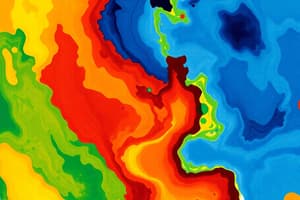Podcast
Questions and Answers
What is the main purpose of latitude and longitude measurements?
What is the main purpose of latitude and longitude measurements?
- To chart weather patterns across different regions
- To identify the exact position of a place on Earth (correct)
- To measure the distance between two points
- To determine the height above sea level of a location
Which statement accurately describes the equator?
Which statement accurately describes the equator?
- It represents the maximum longitude of 180°.
- It marks the boundary between eastern and western hemispheres.
- It is the furthest point north at 90° latitude.
- It divides the Earth into northern and southern hemispheres and is at 0° latitude. (correct)
How are area references constructed on a map?
How are area references constructed on a map?
- By combining the easting and northing at the lower left corner of the square. (correct)
- By using compass directions to navigate to the coordinates.
- By identifying the central point of the grid square.
- By writing the northing before the easting.
What do the terms 'eastings' and 'northings' refer to?
What do the terms 'eastings' and 'northings' refer to?
Which of the following is true about grid references?
Which of the following is true about grid references?
What is the maximum degree of latitude achievable?
What is the maximum degree of latitude achievable?
When constructing a grid reference, what must you do first?
When constructing a grid reference, what must you do first?
Why is the area reference considered limited?
Why is the area reference considered limited?
What is the first step to determine a grid reference on a map?
What is the first step to determine a grid reference on a map?
Which geographical feature typically indicates a high elevation?
Which geographical feature typically indicates a high elevation?
What does relief in geography specifically describe?
What does relief in geography specifically describe?
How can contour lines on a topographical map be defined?
How can contour lines on a topographical map be defined?
Which statement about spot heights is true?
Which statement about spot heights is true?
What does a low relief landscape indicate?
What does a low relief landscape indicate?
Which of the following methods is used to calculate relief?
Which of the following methods is used to calculate relief?
What is the purpose of a topographical map?
What is the purpose of a topographical map?
Flashcards are hidden until you start studying
Study Notes
Latitude & Longitude
- Locations on Earth are defined by latitude and longitude, measured in degrees (°).
- Latitude indicates distance north or south from the equator, with the equator at 0° latitude.
- Latitude ranges from 0° at the equator to 90° at the poles (90° N at the North Pole, 90° S at the South Pole).
- Longitude indicates distance east or west from the prime meridian in Greenwich, England, also at 0° longitude.
- Longitude ranges from 0° to 180° east and west of the prime meridian.
Area & Grid Reference
- Eastings are horizontal numbers on a map, increasing towards the east, while northings are vertical numbers, increasing towards the north.
- To find an area reference (AR), write the easting and northing of the lower left corner of a square on the grid, always in the order of easting before northing.
- Area references consist of four digits, formatted as two-digit eastings followed by two-digit northings.
- For precise location identification, grid references are used, dividing eastings and northings into tenths.
- The grid reference combines the three-digit easting with the three-digit northing to form a six-digit reference for a specific point, enhancing map communication and usability.
Relief
- Relief measures the difference in elevation between the highest and lowest points in a landscape, typically noted in meters (m) or feet (ft).
- Common geographical features include mountains (high elevation), valleys, plains, and plateaus (generally lower elevation).
- Landscapes with greater elevation variation are described as high relief, while those with minimal variation are low relief.
- Topographical maps illustrate relief through spot heights (exact elevations) and contour lines (illustrating elevation changes).
- Spot heights mark specific heights above sea level, while contour lines depict the land's shape, with numbers indicating elevation.
- Relief can be calculated by subtracting the lowest elevation point from the highest elevation point in the area.
Scale
- Maps are a scaled-down representation of geographic areas, aiding in spatial understanding and navigation.
Studying That Suits You
Use AI to generate personalized quizzes and flashcards to suit your learning preferences.




